At Agropharm, with over 20 years of experience in agricultural consulting and project development, we specialize in high-yield crops and are committed to advancing the cannabis sector. As a leading authority in horticulture, we help growers and investors navigate the world of cannabis concentrates. Cannabis concentrates have gained immense popularity due to their potency and versatility. In this post, we will explore the different types of cannabis concentrates available and their effects, helping you understand how to choose the best cannabis concentrates for your needs. Whether you’re a producer, consumer, or investor, understanding these concentrates is key to making informed decisions in the rapidly growing cannabis industry.
Hash (Hashish)
Hash, also known as hashish, is one of the oldest and most well-known cannabis concentrates. This concentrate is made by collecting the trichomes (resin glands) from the cannabis plant. Trichomes contain cannabinoids like THC and CBD, along with terpenes that contribute to the aroma and flavor of the cannabis. The process of creating hash involves sieving dried cannabis flowers or using methods like the ice-water extraction (bubble hash) to collect these precious trichomes.
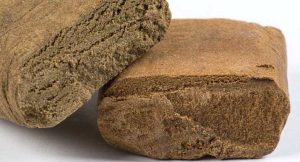
Production process:
- Trichome Collection: The resinous trichomes are extracted either by sieving the dried flower or through methods such as the ice-water bubble hash technique.
- Compression: Once the trichomes are collected, they are compressed and lightly heated to form blocks of hash.
- Purification: Some methods purify the hash to remove contaminants and residual plant material, ensuring a cleaner product.
Characteristics:
- Texture: Hash can range from sticky and soft to hard and brittle, depending on the production method.
- Color: The color of hash varies from light yellow to dark brown or even black, influenced by the purity and method used in production.
- Potency: Hash typically contains a higher concentration of THC than regular cannabis flowers, making it more potent.
- Aroma: Hash has an earthy, intense aroma, with variations depending on the strain of cannabis used.
Consumption:
- Smoking: Hash can be smoked in a pipe, bong, or mixed with cannabis flower in a joint for a more potent effect.
- Vaporization: For a smoother experience, hash can be vaporized using devices specifically designed for concentrates.
- Infusion in Foods: It is also commonly used to make cannabis-infused butter or oil for edibles.
Hash remains a staple in the world of cannabis concentrates due to its rich history, potent effects, and versatility in consumption methods.
Kief
Kief is a cannabis concentrate made from the trichomes, or resin glands, of the cannabis plant, which are the tiny, crystalline structures that contain the plant’s cannabinoids (like THC and CBD) and terpenes. Unlike other concentrates, kief is the simplest form, as it is essentially the pure trichomes sifted from the cannabis flowers. The texture of kief is a fine powder, which can range in color from light green to brown, depending on the strain and purity.
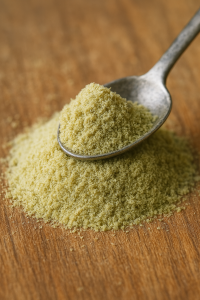
Extraction process:
- Collection: The trichomes are collected by gently agitating the cannabis flower. This process is often done with a grinder that has a kief compartment, or using fine screens that sift the trichomes from the plant material.
- Sifting: The cannabis is sifted through a fine mesh to separate the trichomes from the remaining plant matter.
- Accumulation: The kief accumulates at the bottom of the grinder or on a flat surface after sifting, ready to be used or pressed into other forms of concentrates.
Characteristics:
- Texture: Kief has a fine, powdery texture, similar to powdered sugar or pollen.
- Color: The color of kief can vary, from white or light green to brown, depending on its purity and the strain used.
- Potency: With its high THC content, kief is typically more potent than regular cannabis flower. It contains a concentrated amount of cannabinoids.
- Aroma: Kief has an intense, aromatic scent due to the high concentration of terpenes, providing a richer flavor profile when smoked or vaporized.
Consumption:
- Sprinkling on Joints: Kief can be sprinkled over cannabis flower in a joint or pipe to increase potency and enhance flavor.
- Dabbing: It can be vaporized using a dab rig, providing a smooth, potent experience.
- Pressed into Hash: Kief can be pressed into hashish, increasing its potency and making it easier to handle.
- Infusions: Like other concentrates, kief can be used to make cannabis butter or oil for use in edibles.
Kief is popular for its ease of use, potency, and versatility, offering an excellent entry point into the world of cannabis concentrates.
Shatter
Shatter is a highly potent cannabis concentrate known for its glass-like, translucent appearance. It’s produced through a process called supercritical CO2 extraction, which preserves the purity of the cannabinoids and terpenes, resulting in one of the cleanest forms of concentrate available. The concentrate is brittle and can easily break into shards, hence the name “shatter.”
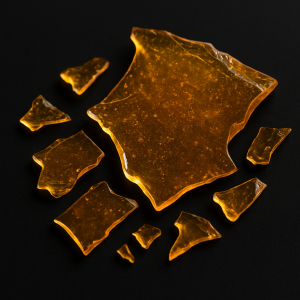
Production process:
- Preparation and Loading: Cannabis flowers are placed into a CO2 extractor chamber.
- Supercritical Extraction: CO2 is compressed and cooled to extract the cannabinoids and terpenes from the plant material.
- Purification: The extract is separated from the CO2, and any remaining solvent is purged.
Characteristics:
- Texture: Shatter is brittle and breaks easily, giving it a glass-like appearance.
- Potency: It’s one of the most potent concentrates, with THC levels often exceeding 80%.
- Consumption: Shatter is typically consumed through dabbing or vaporizing, providing a fast-acting, intense effect.
Cannabis Distillate
Cannabis distillate is one of the purest forms of cannabis concentrate, known for its high cannabinoid content. It’s created through a process called distillation, where cannabinoids like THC or CBD are separated from the rest of the plant’s compounds, resulting in a clean, potent product with up to 99% purity.
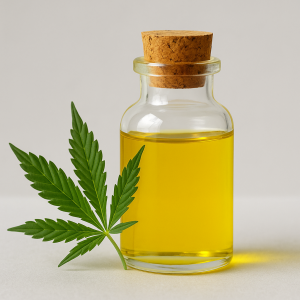
Production process:
- Initial Extraction: A raw cannabis concentrate is obtained through solvents such as butane, propane, or CO2, or solventless methods like rosin.
- Decarboxylation: The raw concentrate is heated to activate cannabinoids, converting THCA into THC or CBDA into CBD.
- Distillation and Refinement: The concentrate is distilled to remove impurities and achieve a highly refined product.
Characteristics:
- Texture: The distillate is typically viscous and liquid.
- Potency: It contains up to 99% THC or CBD.
- Consumption: Distillates are ideal for use in vaporizers, dab rigs, and edibles.
Live Resin
Live resin is a premium cannabis concentrate prized for its rich flavor and aromatic profile. Unlike other concentrates made from dried cannabis, live resin is made from fresh, frozen plants, preserving the plant’s full terpene and cannabinoid content. This results in a concentrate with a fuller, more robust flavor and aroma.
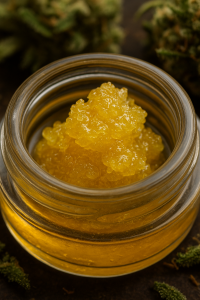
Production process:
- Harvest and Freezing: The cannabis plants are frozen immediately after harvest, before they undergo the drying or curing process.
- Extraction: Solvents are used to extract cannabinoids and terpenes from the frozen plant material.
- Purification: The solvent is removed, leaving behind a pure resin rich in terpenes.
Characteristics:
- Texture: The texture of live resin can vary from sticky and viscous to more solid and crystalline.
- Potency: It has a high concentration of cannabinoids and terpenes, offering a potent experience.
- Consumption: Live resin is typically used for dabbing or in vaporizers.
Crumble
Crumble is a dry, brittle cannabis concentrate known for its crumbly texture, which is easy to handle and highly potent. With a high concentration of cannabinoids, especially THC, crumble delivers a powerful experience with intense effects. It is typically made using solvent-based extraction methods, such as butane or CO2, followed by a process to purge the extract of residual solvents.
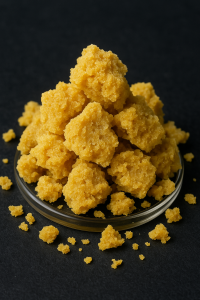
Production process:
- Extraction: Cannabis is extracted using solvents like butane or CO2 to pull out cannabinoids and terpenes.
- Purging: The extract is purged using heat and vacuum, removing solvents and leaving behind a clean concentrate.
- Drying: The concentrate is agitated during drying to achieve the characteristic crumbly texture.
Characteristics:
- Texture: Crumble is dry and brittle, breaking apart easily.
- Potency: With THC levels above 60%, it offers potent effects.
- Consumption: Crumble is ideal for dabbing, vaporizing, or mixing with flowers for enhanced potency.
Rosin
Rosin is a solventless cannabis concentrate that is made by applying heat and pressure to cannabis flowers, kief, or hash. This method preserves the cannabinoids and terpenes without using harmful chemicals or solvents, making it a popular choice for those seeking a pure and natural concentrate.

Production process:
- Selection of Raw Material: Cannabis flowers, kief, or hash are chosen for extraction.
- Application of Heat and Pressure: A rosin press applies heat and pressure to the plant material, causing cannabinoids and terpenes to release in the form of resin.
- Collection: The resulting rosin is carefully collected from the parchment paper used in the press.
Characteristics:
- Texture: Rosin has a sticky, honey-like consistency, but can also be more solid or waxy.
- Potency: Rosin retains high levels of cannabinoids and terpenes, offering potent effects.
- Consumption: Ideal for dabbing, vaporizing, or infusing into edibles.
Badder
Badder, also known as batter, is a cannabis concentrate characterized by its creamy, whipped texture. It’s valued for retaining a high concentration of terpenes, offering a flavorful and aromatic experience. The smooth, manageable consistency makes it easier to handle compared to other concentrates, making it a popular choice for both new and experienced users.
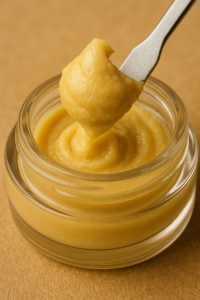
Production process:
- Extraction: Cannabinoids and terpenes are extracted from cannabis using solvents like butane or CO2.
- Purification: The extract is purified to remove any residual solvents and impurities.
- Whipping: The concentrate is whipped during or after purging, incorporating air and creating its signature creamy texture.
Characteristics:
- Texture: Soft and creamy, similar to whipped butter.
- Potency: High in cannabinoids, providing a potent effect with a rich flavor.
- Consumption: Badder is typically used for dabbing, vaporizing, or infusing into edibles.
Cannabis Sugar
Cannabis sugar is a crystallized concentrate known for its granular texture, resembling sugar crystals. It is a versatile and potent concentrate often used in edibles and other cannabis preparations. With a high concentration of THC or CBD, cannabis sugar offers a quick onset of effects, making it a favorite for both recreational and medicinal users.
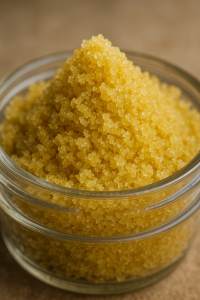
Production process:
- Extraction: Cannabinoids and terpenes are extracted from cannabis using solvents such as butane, propane, or CO2.
- Purification: The extract is purified to remove solvents and other impurities.
- Crystallization: The purified concentrate undergoes crystallization, forming sugar-like crystals, which are then dried and collected.
Characteristics:
- Texture: Granular, resembling sugar crystals.
- Potency: Cannabis sugar has a high concentration of THC or CBD, making it potent.
- Consumption: Ideal for making cannabis-infused edibles, beverages, or for sublingual use.
Cannabis Isolate
Cannabis isolate is the purest form of cannabis concentrate, containing 99% pure THC or CBD. Through an intensive extraction and refinement process, all other cannabinoids, terpenes, and plant material are removed, leaving only the desired cannabinoid in its most concentrated form. This makes cannabis isolate ideal for users seeking a precise and potent dose.
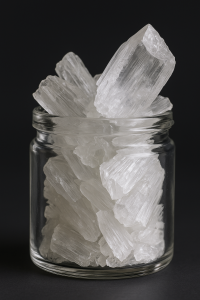
Production process:
- Extraction: Cannabinoids are extracted from the cannabis plant using solvents such as CO2 or ethanol.
- Winterization: Unwanted plant material and other compounds are removed during this process.
- Distillation and Crystallization: The extract is further refined and crystallized to isolate the desired cannabinoid.
Characteristics:
- Texture: Cannabis isolate is typically a fine powder or crystal.
- Potency: Contains 99% THC or CBD, making it extremely potent.
- Consumption: Ideal for use in edibles, tinctures, topicals, or can be vaporized for direct inhalation.
Legal and health considerations
When working with cannabis concentrates, it is important to understand the legal and health-related aspects associated with their use. The legality of cannabis concentrates varies by jurisdiction, and it’s essential to comply with local laws to avoid legal complications. Depending on the country or state, concentrates may be regulated differently, and it’s crucial to stay informed about current legislation.
- Quality and purity: Obtaining cannabis concentrates from reputable sources is vital to ensure the product is pure and free from contaminants. Poor-quality concentrates may contain residual solvents or other harmful substances, which can pose health risks.
- Responsible use: Due to the high potency of some cannabis concentrates, especially products like shatter or distillates, it’s important to use them responsibly. Overconsumption can lead to adverse effects such as anxiety or impaired judgment. Always start with a small dose to assess tolerance.
Note: Always consult a medical professional if you are considering using cannabis for medicinal purposes.
Agropharm’s expertise in cannabis cultivation and concentrates
Our experience extends beyond traditional agriculture into the emerging cannabis industry, where precision and quality are crucial for success. As specialists in technical horticulture, we understand that the production of cannabis concentrates requires not only the right genetics but also the ideal growing environment.
Agropharm’s approach to cannabis cultivation ensures that every stage, from seed to concentrate, maximizes potency and quality while minimizing energy expenditure and environmental impact.
Whether you’re developing a new cannabis operation or refining an existing one, our team provides tailored solutions to help you succeed in this competitive market. With the growing popularity of cannabis concentrates, it’s vital to select the best methods and products for your needs.
Agropharm’s technical expertise supports producers and investors in navigating the complexities of cannabis concentrate production, ensuring that your products meet the highest standards of quality, consistency, and profitability.
Contact us today to discuss your project and discover how we can help you maximize quality and profitability. Reach out to our team of experts and start your journey toward success in the cannabis industry.
